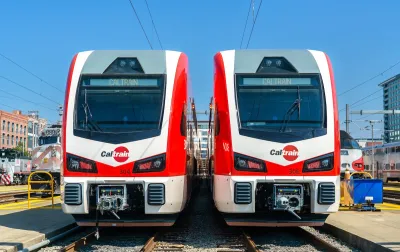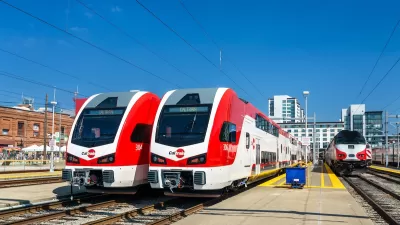U.S. rail agencies are slowly making the shift to zero-emissions trains, which can travel longer distances without refueling and reduce air pollution.

U.S. rail agencies are looking to shift to zero-emissions trains by using battery-powered and hydrogen-fueled trains, and Smart Cities Dive’s Dan Zukowski outlines some of the biggest projects currently underway.
In California, where the state has committed to building a zero-emission passenger rail network by 2050, a hydrogen-powered train is expected to go into service in San Bernardino County in November. The train broke a record during testing for traveling 1,741.7 miles without refueling or recharging. Hydrogen-powered trains emit only water vapor as a byproduct, limiting air pollution in surrounding communities, and are a better solution for longer distances where electric trains might require recharging.
While electrified trains and streetcars are nothing new — in fact, they’re more than a century old — many of the networks that existed in U.S. cities were dismantled or fell into disrepair, and systems using overhead wires or third rails are expensive to maintain. Battery-powered trains can operate on the same rails with less infrastructure, making it possible to extend electrification projects into more areas where the cost of wiring would be prohibitive.
FULL STORY: Where battery and hydrogen-powered trains are coming to US commuter rail

Alabama: Trump Terminates Settlements for Black Communities Harmed By Raw Sewage
Trump deemed the landmark civil rights agreement “illegal DEI and environmental justice policy.”

Planetizen Federal Action Tracker
A weekly monitor of how Trump’s orders and actions are impacting planners and planning in America.

The 120 Year Old Tiny Home Villages That Sheltered San Francisco’s Earthquake Refugees
More than a century ago, San Francisco mobilized to house thousands of residents displaced by the 1906 earthquake. Could their strategy offer a model for the present?

LA’s Tree Emergency Goes Beyond Vandalism
After a vandal destroyed dozens of downtown LA trees, Mayor Karen Bass vowed to replace them. Days later, she slashed the city’s tree budget.

Sacramento Leads Nation With Bus-Mounted Bike Lane Enforcement Cameras
The city is the first to use its bus-mounted traffic enforcement system to cite drivers who park or drive in bike lanes.

Seattle Voters Approve Social Housing Referendum
Voters approved a corporate tax to fund the city’s housing authority despite an opposition campaign funded by Amazon and Microsoft.
Urban Design for Planners 1: Software Tools
This six-course series explores essential urban design concepts using open source software and equips planners with the tools they need to participate fully in the urban design process.
Planning for Universal Design
Learn the tools for implementing Universal Design in planning regulations.
Ada County Highway District
Clanton & Associates, Inc.
Jessamine County Fiscal Court
Institute for Housing and Urban Development Studies (IHS)
City of Grandview
Harvard GSD Executive Education
Toledo-Lucas County Plan Commissions
Salt Lake City
NYU Wagner Graduate School of Public Service





























